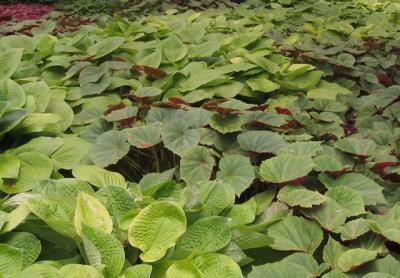Star Gardener: Groundcovers for Shade

A forest glade with a thick carpet of ferns, etched in dappled sunlight cast by the shade of trees, has been a recurring dream since I first saw the island bed by Hollis Forbes’s driveway in East Hampton.
It is only a simple and small space, with three American hollies underplanted with Christmas ferns, created to shield the view of the drive from her front door. But it illustrates how the right groundcover can transform a planting from simple to memorable.
The decision to mass Christmas ferns was inspired. The fronds are dark green, with an architectural shape bold enough to hold their own against the glossy leaves of the hollies. The plant is evergreen, remaining upright through much of the winter, and it doesn’t need to be cut back until March, just beforethe new fronds emerge. Of equal importance, it is a clump-former rather than a runner, reducing maintenance in an enclosed space.
We look to groundcovers to suppress weeds, but they can and ought to do far more. Especially in shady areas, broad swathes of plants of contrasting textures and varying shades of a single color can weave a tapestry that is beautiful as well as functional.
As I was mulling over this idea, I visited Chanticleer in Wayne, Pa. What did we see: A large wooded area underplanted with alternating masses of soft green hostas and darker green-leafed hardy begonias, almost as far as the eye could see. The matte foliage of the begonia, with its jagged edges, accentuated the puckered round leaves of the hostas.
In other areas at Chanticleer, fine-bladed sedges (grass relatives, for shade) were massed at the edges of shrub borders for a naturalistic feeling.
A word of caution, however: Choose your sedges (carex) carefully. At the Native Plant Garden in East Hampton, a spreading species was planted in the central mound toward the rear. It looks beautiful, especially now that the butterfly weed is in full flower, but it is the devil to maintain. It spreads relentlessly across the path and requires more strength than I have to clear it away every spring.
On the other hand, two types of clump-forming sedges were planted at the entrance to the grass garden at LongHouse 11 years ago and they still look good. Planted densely, the effect is similar visually — they keep down the weeds, and you don’t have the nasty job of containing them in limited space every year. One, Carex Velebit Humilus, creates a low mound of green with narrow blades, and the other, C. Silk Tassel, about a foot high with thread-like foliage, is a long-lived alternative to Mexican feather grass. There is an ever-growing list of clump-forming evergreen sedges from which to choose.
An imaginative use of groundcovers in shades of soft yellow and green is bringing the illusion of brightness, if not actual sunshine, into what had been a dark view of the woods from Carol Mandel’s kitchen window in Sag Harbor.
Facing west, the wooded area slopes downward, with an enclosed garden room at the bottom. The trees were limbed up and the hillside cleared just enough to see hints of the garden. She and her husband, Vincent Covello, selected three soft yellow plants of different textures to play off one another: variegated Japanese forest grass (Hakonechloa macra Aureola); a medium hosta, Gold Standard, and a soft yellow heuchera. The hakonechloa dominates, and next summer, after the plants knit together, the hillside will seem like a golden river tumbling downward.
On the shady western side of my garden, I too used plants with yellow foliage to brighten an otherwise dull area. The groundcover golden creeping Jenny, Lysimachia nummularia Aurea, glows like molten gold when the sun finally reaches it in the afternoon. It accentuates the colors in the leaves of a golden full-moon maple and dwarf Hinoki cypress with lace-like golden needles, while the purple leaves of Euphorbia Chameleon pop against the golden groundcover.
Two other groupings of groundcovers in my garden are working out well. In one, three cultivars of Japanese painted fern with different dominant color combinations (all green, mostly silver and mostly maroon) form a mosaic, showcasing the huge white mopheads of Annabelle-type hydrangeas and large hostas.
The second combines the fine foliage of sweet woodruff with the bold, wide blades of Carex siderosticha Variegata. Growing under Virginia cedars and in front of osmanthus, it seems an idealized forest floor. Sweet woodruff grows rapidly, but because its roots run just under the surface, it is easily controlled.
There is more to groundcovers than pachysandra and English ivy. Carefully selected, they can be the ultimate accessory to elevating a planting to a thing of beauty.
